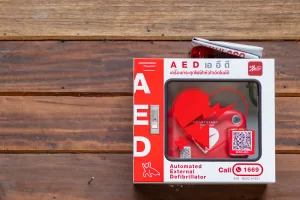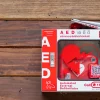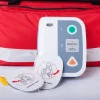
Recent Post
- What Maintenance Is Required for an AED: Everything You Need To Know
November 14, 2025  Could You Recognise the Signs That Someone Needs a Defibrillator?
Could You Recognise the Signs That Someone Needs a Defibrillator?
September 12, 2023
Automated external defibrillators (AEDs, or defibs) are life-saving medical devices designed for easy use in public emergencies by people without medical training. They offer critical support during sudden cardiac arrest, often before emergency services can even arrive.
It’s in these time-sensitive situations that it’s vital to ensure your AED is properly maintained, and that includes understanding everything there is to know about AED battery maintenance and disposal. At Priority First Aid, we provide top-quality first aid and CPR equipment, along with expert guidance, to help you maintain and use it effectively.
This article will cover everything you need to know about AED batteries, including how often they should be replaced and how to properly dispose of them, so you can be confident that your AED will be ready when it matters most.
The Importance of AEDS and Their Batteries
AEDs are crucial life-saving devices designed to provide immediate assistance during sudden cardiac arrest, one of the leading causes of death worldwide. These portable machines analyse an individual’s heart rhythm and, if necessary, deliver an electric shock to help restore a normal heartbeat.
At the heart of every AED is its battery, the power source that ensures the device is ready to deliver a shock when seconds count. Without a reliable, charged battery, an AED is useless in an emergency. That’s why understanding how often AED batteries should be replaced is crucial for maintaining your device’s functionality and compliance with legal safety standards.
How Often Should AED Batteries Be Replaced?
AED batteries typically last between 2 and 5 years, depending on the device model, battery type, and environmental factors. This lifespan estimate varies widely because AED manufacturers design their devices with different battery technologies and power consumption rates.
What Kind of Battery Does an AED Use? NEW CONTENT
The majority of AEDs in public settings only use non-rechargeable batteries, which are strictly single-use and often lithium-based. Why? Because they provide long shelf life and a stable, reliable output. However, once depleted or expired, they must be replaced entirely to maintain their rescue-ready status.
At Priority First Aid, our AEDs come with non-rechargeable batteries that are backed by specific warranty periods and meet high-quality standards from our carefully selected manufacturers. Why? Because it is vitally important to us that the reputable brands that we have specifically chosen to supply are reliable and maintain a rescue-ready status for when an emergency arises. Examples of AEDS that use non-rechargeable batteries are the HeartSine Samaritan PAD, Philips HeartStart, Defibtech, and Zoll.
Rechargeable batteries, on the other hand, are primarily used in settings where AEDs are frequently used, such as in hospitals and ambulances. It’s important to note that rechargeable batteries are not recommended to be sold for public or community use, which is why, at Priority First Aid, we do not supply AEDs with rechargeable batteries. Furthermore, for AEDs used in personal or community settings, Priority First Aid believes that relying on rechargeable batteries poses a significant risk that a device may not be ready when needed.
Why We Recommend AEDs with Non-Rechargeable Batteries OLD CONTENT
Non-rechargeable batteries are single-use batteries, often lithium-based, which provide long shelf life and stable power output. Once depleted or expired, they must be replaced entirely. Examples include batteries used in popular AED models, such as the HeartSine Samaritan PAD, Philips HeartStart, Defibtech, and Zoll.
Priority First Aid does not supply AEDs with rechargeable batteries. Instead, our devices come with non-rechargeable batteries that are backed by specific warranty periods and meet high-quality standards from our carefully selected manufacturers. Why? Because it is vitally important to us that the reputable brands that we have specifically chosen to supply are reliable and maintain a rescue-ready status for when an emergency arises.
To ensure an AED maintains rescue-ready status, we recommend replacing batteries by the expiry date. For AEDs used in personal or community settings, Priority First Aid believes that relying on rechargeable batteries poses a significant risk that a device may not be ready when needed.
Factors That Affect Defib Battery Life
There are several factors that can influence the lifespan of your AED, including:
- Temperature: Extreme temperatures, both hot and cold, can impact the battery’s condition and reduce its lifespan. Storing AEDs in temperature-controlled environments is important.
- Frequency of self-checks: Most AEDs perform automatic self-tests to verify functionality, which consume some battery power.
- Frequency of use: If an AED is used in an emergency or for training, its battery life may be shortened, requiring earlier replacement.
- Storage conditions: Exposure to moisture, direct sunlight, or dust can affect battery health.
Checking Expiry Dates and Status Indicators
Every AED battery comes with an expiry date or recommended replacement date printed on its packaging or the battery itself. Using batteries past this date increases the risk of failure during an emergency. All AEDs feature status indicators, which are lights or icons on the device that show whether the device is operationally ready. Regularly monitoring these indicators is important to ensure the device is always ready for use.
When Should You Replace the AED Battery?
Knowing when to replace your AED battery is crucial for avoiding potential device failure and ensuring compliance with safety standards.
Signs You Need to Replace the Battery
To keep your AED ready for emergencies, it’s crucial to recognise when the battery needs replacing. Here are some common signs that it’s time for a new battery:
- Battery Status Indicator Shows Low or Empty: Many AEDs have a battery icon or LED that signals when the battery power is low.
- Manufacturer’s Recommended Replacement Schedule: Follow the manufacturer’s guidelines, which typically range from 2 to 5 years, depending on the battery type.
- Audible or Visual Alerts: Beeping sounds or flashing lights often indicate the battery needs replacement.
Recommended Maintenance and Checks
Routine maintenance is essential for AED readiness. Experts recommend monthly visual inspections of the battery status and device readiness indicators. However, please ensure that you are familiar with the manufacturer’s guidelines for maintenance and checks for your specific AED brand (Zoll, Defibtech, Lifepak, Heartsine, Philips), which include ensuring the battery and electrode pads are within their expiry dates and are operationally ready.
Risks of Delaying AED Battery Replacement
Delaying defibrillator battery replacement can lead to:
- AED failure during a cardiac emergency, which could lead to preventable fatalities.
- Legal consequences in workplaces due to non-compliance with safety regulations.
- Increased liability and potential insurance issues if the device doesn’t perform when needed.
How to Properly Dispose of AED Batteries
Knowing how to dispose of AED batteries is important not just for environmental safety, but also to comply with local waste regulations and reduce fire hazards. Improper disposal, especially of lithium batteries, can lead to serious environmental damage or safety risks.
Disposal by Battery Type
Different AED battery types require different disposal methods. Lithium batteries require special handling due to their unique chemical composition and fire risk. They should always be taken to a hazardous waste facility or a designated battery recycling centre. Alkaline batteries, while less dangerous, still contain materials that shouldn’t end up in general waste bins. Wherever possible, they should be disposed of through a proper battery recycling program.
Key Points to Remember When Disposing of AED Batteries
Proper disposal of AED batteries is essential for both safety and environmental responsibility. To ensure you’re handling used batteries correctly, keep these key points in mind:
- Local councils often provide drop-off points for battery recycling. Check out Recycle Mate to find your nearest battery recycling location.
- Do not dispose of AED batteries in regular household or workplace waste bins, as this can pose environmental hazards and, in the case of lithium batteries, potential fire risks.
Reach Out to Priority First Aid
We hope that we’ve been able to clarify a few things for you in this article. However, if you do have any more questions or would like to discuss our different AED options, please feel free to contact us. We’re more than happy to help you choose the right AED for your needs and provide any guidance you may need around battery care and replacement.




